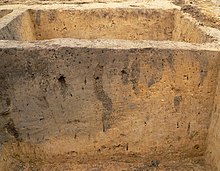Crotovine
Krotowinen (from Russian кротовина, krotowina for " molehills " or "-gang") are burial tunnels filled with loose soil material in soils that originate from small mammals . It is therefore a special expression of bioturbation . The tunnels, which have a diameter of several centimeters to a few decimeters, are usually caused by rodents such as hamsters , ground squirrels or prairie dogs . The animals are driven by winter cold or summer drought to migrate vertically in the ground.
Crotovins are common in the soils of steppe landscapes . They are characteristic of black earths or Chernozems and Phaeozems . In soil profiles they are visible as round humus spots in the subsoil made of loess or loess- like material (B or C horizon) or as light spots made from subsoil material in the humus topsoil (A horizon). The burrows create an interlocking of these two soil horizons .
swell
- Crotovine. In: Spectrum Online Lexicon of Geography.
- Hans Murawski, Wilhelm Meyer: Geological dictionary. 12th edition. Spektrum, Heidelberg 2010, ISBN 978-3-8274-1810-4 , pp. 91, 99, 149. (books.google.de)
- Wulf Amelung, Hans-Peter Blume, Heiner Fleige, Rainer Horn, Ellen Kandeler, Ingrid Kögel-Knabner, Ruben Kretzschmar, Karl Stahr, Berndt-Michael Wilke: Scheffer / Schachtschabel, textbook of soil science. 17th edition. Springer Spectrum, Heidelberg 2018, ISBN 978-3-662-55870-6 , p. 410. (books.google.de)
Web links
- Collection item of the month. 11/05: Hildesheim Black Earth - with photos of the corresponding soil profile and labeling of the soil horizons and structures (including crotovines), website of the Federal Institute for Geosciences and Raw Materials

